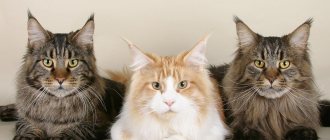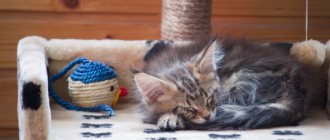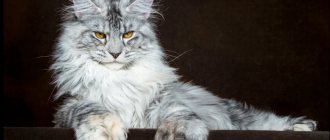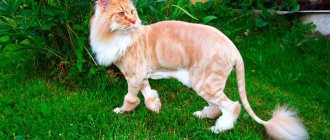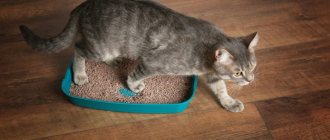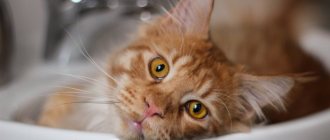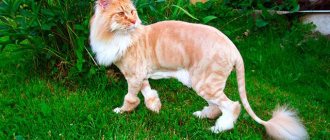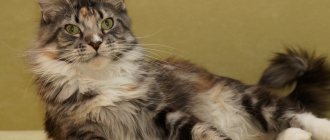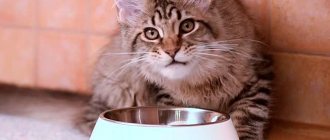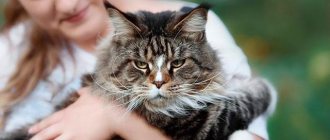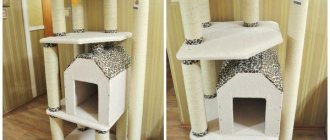Maine Coons have a luxurious, lush coat, which consists of two types of hair - a thick undercoat and a long, hard outer coat. Because of this structure, the appearance of the coons is very impressive. A cat that meets the standards has short hair on the head, thick and long hair on the collar area, on the belly and sides, and a fluffy tail. Thanks to the well-developed undercoat, the animal appears even larger.
Types of rulers
Coons shed for several reasons:
- Hormonal changes in the body.
- Seasonal changes.
- Health problems.
The first two are considered normal and natural for cats. The average lifespan of a hair is 25 days. By the time it matures, it moves away and falls out, but in animals with medium or long hair, the hairs usually become tangled and remain in the main coat.
With a very thick undercoat, shedding is accompanied by tangles; the situation is similar with a thin non-pedigree structure. Therefore, during this period it is important to take proper care, without neglecting special cosmetics or visiting a salon. In coons, the type of coat largely depends on the breeding lines, you should pay attention to this. In cats, the process is more intense. Each molt lasts about one month, sometimes more or less.
Seasonal
[ads-pc-1] This type of molting occurs when the animal independently regulates heat exchange.
In street pets it usually appears twice a year. Within a month, cats shed excess hair. The onset depends on temperature changes in nature. In domestic coons, the boundaries may be blurred, and more reasons appear. For example, dry and warm air in the apartment activates the process, which helps to avoid overheating. Sometimes diaper rash forms under a layer of old wool, tangles, which become a good environment for the development of various fungal diseases. But Maine Coons with the breed's coat structure are not prone to such manifestations, provided they receive sufficient care.
Some hairs die off constantly. Coons have hair that grows all year round, and they shed it regularly, but in small quantities. The hairs “come out” of the bulb. Seasonal shedding is easily recognized - the cat becomes less furry, and this is very noticeable. In addition, lumps of hair may appear in the stool, and the animal also regurgitates hair that got into the stomach after licking. This is a normal process for coons, but it needs to be monitored and, if anxiety occurs, help remove shed hair from the cat’s body.
Age
Coon kittens have a fairly thick undercoat, but the true color often appears after puberty.
At the age of 7-12 months (individually), cats exchange delicate fluff for adult “clothes”. This is how the junior molt begins. Under the influence of hormones, children's hair falls out. In their place, others grow, the cat’s spine becomes longer, the color is brighter, and the general appearance of the animal changes. During this period, hair loss can seem like a real disaster. In cats the intensity is less. This first coat change begins from the head. Complete renewal of the cover can occur only by 2 years. Much depends on the body’s abilities, genetic predisposition, and the conditions under which the coons are kept. Until this moment, the pet will not have strong hair growth.
Hormonal stress in cats also includes pregnancy, estrus, and the period of feeding offspring. It happens that an animal sheds almost to a bald state where the hair is initially thin (armpits, belly). After recovery, cats quickly return to their previous appearance.
Signs of illness
The condition of a cat's fur is one of the main indicators for determining diseases. Often the impetus for molting is:
- Stress.
- Problems with the gastrointestinal tract.
- Allergic reactions.
- Other diseases.
The first factor can be dealt with quite easily, but the calmness of cats cannot be neglected. Before an exhibition, long trips, moving to another home, or meeting a new member of the pack, it is advisable to give sedatives on a natural basis if the cat is prone to stress.
In the case of inappropriate nutrition, even bald spots can occur, which are difficult to treat. Eczema, dandruff, and dulling of the coat are possible, but Maine Coons are characterized by good health. In this case, food is selected, but with a preliminary visit to the veterinarian and testing.
Allergies can also be caused by improper feeding, chemical and mechanical irritations. Then the coon sheds in certain areas, usually near the ears, at the base of the tail, and the stomach. Timely treatment with the use of ointments, gels, special cosmetics and changes in diet helps.
Care during shedding
Many Maine Coons are not afraid of water and love to play with it. You can take advantage of this quality by teaching your kitten to wash itself from an early age. During the process of shedding hair, bathing with shampoo and then brushing will help relieve the cat's condition.
A hair dryer also helps. Warm air blows away dead hairs. Shampoos from certain series are suitable for washing cats with a two-layer coat during shedding, but even a regular product will improve the situation.
Brushing a Coon breed pet can bring pleasure to both the owner and the animal. When shedding, brushes are used several times a week. After manipulation, they go over the top of the coat with wet hands, collecting hairs so that the Maine Coons do not scatter it everywhere. Additionally, vitamins and mineral supplements are provided to the basic diet. Fatty acids, potassium, omega-3, calcium and zinc have beneficial properties.
Source
The best complexes for kittens
Rapidly growing animals, after switching to independent feeding, need additional microelements, vitamins, and minerals for harmonious growth and development.
Let's consider popular complexes with good reviews:
Kitty's Junior (BEAPHAR, Netherlands)
The drug contains vitamins B1, B2, B5, B12, fiber, potassium, sodium, phosphorus, calcium, biotin. The components will make the baby's coat shiny, healthy, prevent hair loss, and have a positive effect on the condition of the claws. The drug is available in the form of tablets with the taste and aroma of fish. The composition contains at least 4% natural cod.
Advantages:
- pleasant taste;
- rich composition;
- small tablet size;
- convenient dosage (no more than 8 pieces per 1 kg of body weight);
- the result is noticeable almost immediately;
- can be used as a daily supplement to food.
Flaws:
- price.
Doctor ZOO (Russia)
This Russian-made complex can be given starting from three months of age. The drug contains 12 vitamins, bone meal, minerals, amino acids, yeast, biotin, and milk powder.
Advantages:
- pleasant taste;
- natural composition, contains calcium;
- can be given from an early age;
- low price.
Flaws:
- the drug may cause allergies.
Maine Coon sheds a lot, what should I do?
One of the common complaints of Maine Coon owners is severe hair loss. But there is no need to panic: molting does not always signal a disease. The Maine Coon's coat requires special care. If you follow all the recommendations, it will be shiny and silky. When an animal sheds constantly, this is a reason to pay closer attention to its health.
What vitamins should I give my cat for hair loss?
The drugs can significantly shorten the molting period, improve the condition of the coat, remove tangling, and add shine to the fur coat.
POLIDEX SUPER WOOL (Russia)
Due to its rich composition, Polidex normalizes metabolic processes, prevents dermatological diseases, and makes the molting process shorter. The result of the treatment is a bright coat color, shiny coat, a contrasting contour of the nose, and a reduction in hair loss.
Advantages:
- complex effect;
- positive effect on skin, claws;
- getting rid of dandruff;
- absence of fragrances, dyes, flavor enhancers;
- attractive taste;
- hypoallergenic composition;
- affordable price.
Flaws:
- inconvenient dosage.
2. FARMAVIT ACTIVE BEAUTY AND HEALTH OF WOOL (Russia)
Taking the complex is indicated to facilitate shedding, reduce its duration, restore color brightness, get rid of fragility, flaking of the skin, dandruff, and stimulate hair growth. The composition of the drug includes trace elements and minerals. The recommended course is 2-4 weeks.
Advantages:
- convenient dosage (1/2-2 tablets per day);
- contains fruit enzymes that improve the absorption of substances;
- ease of storage;
- natural source of flavonoids;
- wide range of indications;
- excellent ratio between price and quality.
Flaws:
- there is a possibility of developing allergies;
- Strong smell;
- The tablets are difficult to chew.
Causes
Shedding is a natural occurrence in cats, so there is no need to panic about it. The “new” coat has a positive effect on thermoregulation, and the animal feels better. There are more factors influencing this process than it seems.
Heavy shedding of a Maine Coon can be caused by the following reasons:
- non-compliance with hair care recommendations;
- poor nutrition;
- stress;
- seasonality;
- infectious or viral disease;
- allergic reaction;
- adverse environmental influences;
- hormonal changes.
Also, the cause of heavy shedding in Maine Coons may be a genetic predisposition. Therefore, it is worth asking about the condition of his parents’ fur. Owners should not worry if this is a seasonal phenomenon or hormonal changes caused by pregnancy or lactation.
The Maine Coon's coat is thick and soft, so it requires special care. If you use the wrong products, in addition to shedding, itching, dandruff, and the color may become dull. Therefore, you must follow all care recommendations. In other cases, you should contact your veterinarian.
Causes of increased oiliness in cats' fur
Maine Coons often have problems with increased oiliness in the hair in the tail, back and neck. This can happen for several reasons. Firstly, it is a consequence of a metabolic disorder in the animal. Secondly, an increase in the amount of secretion from the sebaceous glands.
If there are problems with oily fur, Maine Coon hair care should include special treatments to reduce the production of skin secretions. Also, along with this, a problem may be detected in the form of black dots at the base of the tail. Such a defect is considered only cosmetic. It can be eliminated using products containing salicylic alcohol.
Before using medications, you should consult a veterinary dermatologist.
The Maine Coon breed is unpretentious in maintenance and easy to care for. These beauties only need regular brushing. Maine Coons should only be bathed when necessary or when dirty. If you approach these procedures responsibly, feed the animal in a balanced manner and monitor its well-being, your pet’s coat will always look beautiful and well-groomed.
Main types of shedding
Experts identify several types of molting, differing in the reasons for its appearance. Treatment methods will depend on the variety:
- Changing baby fur is the very first shedding of a Maine Coon. It occurs when kittens are 5-6 months old. But the timing may shift depending on the physiological characteristics of the kitten. The fluff is replaced by coarse, denser wool. This is a natural process, so owners do not need to worry.
- Maine Coons change coats with the onset of spring and autumn. The animal regulates its heat exchange in this way. In pets, seasonal shedding occurs more often - even in the summer. Normally, this process lasts from 14 days to 2 months. If an animal sheds for longer, this may be a symptom of a disease.
- Domestic Maine Coons experience indoor shedding. Due to the lack of walks, the pet ceases to feel the seasonality. The situation becomes more complicated during the heating season or in the summer if additional equipment is used for cooling. In this case, you should consult a veterinarian who will select a complex of vitamins.
- Shedding is often a concomitant symptom of the disease. There is no need to try to diagnose and prescribe treatment on your own. Only a veterinarian can do this. Distinguish this type of molting by additional signs: lethargic state of the animal, drowsiness, poor appetite, eating disorder. You should be wary if your Maine Coon's hair falls out unevenly. This may indicate an allergy, shingles, or other skin condition. You should not hope that this problem will go away on its own. The sooner the pet is examined by a veterinarian, the faster the pet will recover.
- Sometimes Maine Coon owners complain about constant heavy shedding. At the same time, the cat feels well, there are no alarming symptoms. Poor coat condition can be caused by improper care. You can solve this problem if you start following all the recommendations for caring for your Maine Coon.
- The Maine Coon is a resilient breed, so they rarely shed due to stress. But such situations also happen. Stress can arise due to a move, an exhibition, or the arrival of a new animal in the house.
Tips for solving the problem
Treatment will depend on the type of shedding. Maine Coon owners can help their pet using effective methods. They are preventive measures to eliminate this problem:
- Maine Coon's diet should be reconsidered. The main thing is to exclude fatty foods, because representatives of this breed have difficulty digesting them. The diet should be balanced, it is advisable to add vitamins to it;
- You need to brush your Maine Coon's coat at least twice a day. It is often impossible to bathe an animal, so you can use dry shampoos. But you need to select them taking into account the type of wool. It is often not recommended to use it because it can cause dandruff;
- if the owners do not walk, it is necessary to ventilate the apartment often;
- to prevent stress, it is recommended to spray the scratching post with mint solution once a week;
- Multivitamin complexes must contain vitamins B2, B5 and biotin. They are the ones who influence the condition of the coat. A veterinarian will help you choose the complex, assessing the appearance and general condition of the cat;
- A deficiency of biotin in the body can lead to Maine Coon shedding. To replenish it, the animal needs to be given a raw egg yolk once a week.
Only a veterinarian should prescribe medication. Any self-medication can lead to a deterioration in the animal’s condition. Therefore, if you have doubts about the health of your Maine Coon, you need to take him to the veterinarian.
Bathing
There is no need for regular water treatments, since the animal maintains the excellent condition of the Maine Coon’s coat on its own. Some cats love bathing, but this is rather rare. In most cases, washing has a negative impact on their morale as they experience a lot of stress during the process. Also, frequent washing of the protective layer of fat from the natural cover leads to deterioration of health due to decreased immunity, which is contrary to the rules of care.
Usually, bathing is done immediately before an exhibition, at which the Maine Coon should have an attractive and unique appearance. The care procedure must be carried out taking into account the following features:
- the classic Maine Coon coat becomes shiny after a certain time after bathing, which it is advisable to calculate in advance;
- For washing, only special shampoos are used, selected taking into account the color and type of coat;
- to give the best effect, the Maine Coon's coat is treated with lotions and powders from the same line as shampoo;
- The animal is dried using a hairdryer, after which the fur must be thoroughly combed to avoid curling;
- It is not advisable to stroke a washed Maine Coon cat too often, as this will make its hair dirty much faster and the grooming procedure will have to be repeated again.
© shutterstock
Care during molting
Representatives of this breed love to play with water. Owners are recommended to teach them to bathe from the first years of life. During washing, excess hair falls out, which makes them easier to comb. During the molting process, it is worth using special lines of shampoos. It is better to comb them every day. If that doesn’t work, at least 3 times a week. In order for the Maine Coon to not shed so much, its diet should contain many useful micro and macroelements and vitamins.
Source
Separately regarding nutrition
You also need to choose vitamins for hair growth in cats based on their diet. Food comes in different classes - economy, premium, super-premium, holistic. There are special veterinary lines to solve health problems, food to maintain healthy fur and skin.
note
Quick view
Dry food PERFECT FIT HAIR & SKIN for adult cats with sensitive skin and hair with turkey (0.65 + 0.65 kg)
0.65 + 0.65 kg
606 ₽
547 ₽
Show all offers
Quick view
Dry food BOZITA HAIR & SKIN WHEAT FREE SALMON for adult cats with sensitive skin and hair with salmon (2 + 2 kg)
2 + 2 kg
4 312 ₽
4 020 ₽
Show all offers
Quick view
Dry food BOZITA LARGE WHEAT FREE SALMON for adult cats of large breeds with salmon (10 + 10 kg)
10 + 10 kg
17 298 ₽
16 124 ₽
Show all offers
Quick view
Dry food GENESIS PURE CANADA MY BLUE LAKE HAIR & SKIN grain-free for adult cats with allergies with salmon, trout and chicken (2,268 + 2,268 kg)
2.268 + 2.268 kg
to order
Show all offers
Quick view
Dry food CHICOPEE HOLISTIC NATURE LINE CAT ADULT HAIR & SKIN for adult cats with sensitive skin and hair (8 + 8 kg)
8 + 8 kg
to order
Show all offers
Quick view
Dry food CHICOPEE CLASSIC NATURE LINE CAT ADULT BEAUTY for adult cats with sensitive skin and hair with salmon (1.5 + 1.5 kg)
1.5 + 1.5 kg
to order
Show all offers
Depending on membership in one group or another, the composition of the product and the content of micro- and macroelements changes.
How often should you give anti-shedding vitamins to cats:
- If you feed your purr with expensive and high-quality food, it is recommended to give fortified products 1-2 times a year.
- In all other cases, the frequency of the course should be increased.
If the food contains a rich set of micro- and macroelements, you should not duplicate them in combination. Remember that an excess of vitamins harms the animal no less than a deficiency. Kittens are prescribed vitamin supplements from 6-8 months of age, strictly adhering to the dosage schedule.
Maine Coon Shedding
Shedding in the Maine Coon breed can occur both due to health problems and as a result of natural factors.
Interesting! Shedding is periodic, since each hair lives on average for about a month. If you do not brush your Maine Coon, the dead hair will not be removed, which will cause the coat to become matted.
Seasonal
Maine Coons living in apartments are not affected by sudden changes in temperature, so their shedding is no longer seasonal. Most often it occurs in mid-spring or summer, but due to poor ventilation of the room or unbalanced nutrition, this process can begin at other times.
Age
Maine Coon grooming should begin from childhood, since the pet sheds as it grows.
At the age of six months to a year, the kitten's fur becomes thicker and coarser - at this time, active loss of the baby's undercoat occurs, and the Maine Coon needs to be scratched with a comb or comb at least once a week.
Important! Accustoming your Maine Coon to combing should begin early and gradually, otherwise in the future this procedure will cause aggression in the animal or cause prolonged stress.
Age-related molting can last up to two years - at this time, the body, due to restructuring, needs a large amount of vitamins and beneficial microelements. A deficiency of these substances can cause severe hair loss and deterioration in its appearance.
The health of the Maine Coon is the basis of its luxurious, shiny coat.
First of all, it is necessary to organize proper nutrition for the cat and timely treatment. When eating natural food, you need to ensure that its composition is balanced. Vitamins B and E are responsible for the appearance of fur and skin. If a cat has dandruff or a long period of shedding, it is worth adding liver, brewer's yeast and bran to his diet. In this case, it is necessary to ensure that an overdose does not occur.
The fact is that both a deficiency and an excess of various substances are the cause of dull, brittle wool, prone to matting. In this case, special complexes will help, having a balanced composition and containing a scientifically verified amount of vitamins and microelements.
Cats kept on industrial feed do not need such additives. In this case, the owner’s only task is to ensure the pet’s drinking regime is correct and to prevent overeating. The conditions of keeping a cat, for example, cramped, stuffy enclosures, can also worsen a cat’s appearance.
Sparse, quickly oily fur, excessive shedding, areas with visible skin are reasons to visit the veterinarian. This effect can be achieved by metabolic disorders, chronic and indolent diseases, the symptoms of which are mild.
Care during shedding
The shedding period can last from 25 to 45 months - during this time it is necessary to regularly use a high-quality brush to care for your Maine Coon. If you ignore brushing, the animal may eat the hair. This will negatively affect the functioning of the gastrointestinal tract.
Interesting! Males shed more heavily than male cats.
In addition to using a comb, bathing and blow-drying, as well as introducing vitamins into the diet, will help ease the shedding process.
How to care for Maine Coon fur
Everyday care for your pet's coat includes several steps that require little time and minimal preparation.
Combing
To brush your cat you will need 2 combs:
- with sparse, long teeth will easily remove tangled hairballs;
- with frequent but shorter teeth will remove the remains of fallen hair and dirt.
Combing is carried out from the back of the head towards the tail.
- furminator, designed for grooming dogs;
- slicker, as it can cause microtrauma and severe pain to the pet.
It is also allowed to use rotating comb brushes with rounded metal teeth to care for a cat's fur: they are well suited for combing very long hair that is prone to tangles.
During non-shedding periods, it is recommended to use the comb twice a week.
Bathing and cosmetics
When swimming, you should adhere to a number of rules:
- heat the water to 38 degrees;
- protect the bathroom from drafts;
- Place a small towel at the bottom of the bath and constantly stroke your pet - this will reduce stress levels;
- Do not allow water to get into the cat’s ears and eyes.
You should bathe your pet during shedding, to facilitate it, and during the recovery period after diseases that did not allow the animal to fully care for its coat on its own.
During bathing, special shampoos for long-haired pets are used. Finally, the fur coat is rinsed with good pressure of warm water in the direction of hair growth.
The washed pet should be carefully dried with a soft towel - active friction can greatly tangle the wet fur. If the animal is in the period of molting, it should be dried with a hairdryer; in other cases, the cat should be allowed to lick itself. And only after that you can comb the Maine Coon with a comb.
Fighting tangles
It is not recommended to untangle the tangles found by hand or with a comb; they must be carefully cut out with nail scissors. Most often, the hair gets very tangled in the tail, belly, neck and hind legs.
The main cause of tangles is a skin fungus, which is easily identified by the presence of dandruff. In such a case, it is necessary to visit a veterinary clinic so that a specialist can prescribe antifungal therapy. To prevent the appearance of tangles, it is recommended not to forget about regular use of a comb.
Poor nutrition, lack of hygiene and deteriorating health primarily affect the condition of the animal's coat: it becomes brittle, loses its shine and falls out. To avoid negative consequences, you should carefully monitor your pet’s diet, do not neglect the described rules of care, and conduct preventive examinations with a veterinarian.
Source
When is a haircut needed?
A domestic Maine Coon needs a haircut only if there are problems with hair, skin diseases, or a large number of uncombable tangles in the animal. You should not cut your pet's hair thinking that it is hot in the summer, or simply to improve its appearance. For a good haircut effect, it is recommended to contact a professional groomer. But some owners prefer to groom their cats themselves at home.
Preparing for the Maine Coon grooming process
To prepare a Maine Coon for grooming at home, you need to follow a certain algorithm of actions:
- Bathe using a special shampoo to deeply cleanse the coat. Cats, for the most part, do not like water at all, so when bathing it is worth providing your pet with the most comfortable and calm conditions possible. You need to make sure that shampoo and water do not get on the animal’s face, especially in the eyes and ears.
- After shampoo, you can use conditioner to make it easier to comb the coat.
- It is necessary to thoroughly dry the animal's fur and, after drying, comb out all tangles.
Only after completing all these steps will you be able to start cutting.
Grooming a Maine Coon at home
In order to cut your Maine Coon's hair yourself, you need to have at home several combs with different tooth frequencies, scissors and an animal clipper. The most popular home haircut for cats is the lion haircut. In the area of the animal's head and neck, the hair is left untouched to form a mane. The rest of the fur is shaved as short as possible. Only the tassel on the tail and the hair below the elbow and knee joints on the paws are left.
After grooming, be sure to remove short cut hairs from your pet’s coat using a comb or a damp towel.
View this post on Instagram

